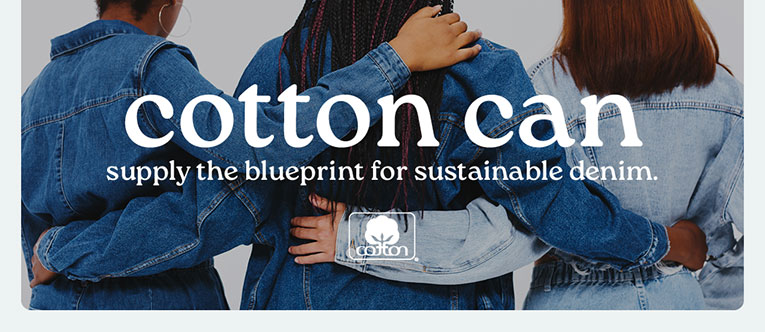Cotton Denim: The Sustainable Staple
Redefining Fashion's Future
Every wash cycle tells a story. For synthetic fabrics, it’s one of microplastic pollution and long-term waste, a problem that has increasingly begun to swirl down our drains and into our ecosystems. But cotton denim tells a different story entirely—one deeply rooted in natural fiber performance and powerfully supported by science.
Across the industry, designers, brands, and manufacturers are seeking out fibers that combine durability and functionality with innovation and sustainability. Here, cotton truly delivers, all while continuing to appeal to shoppers. As a material that consumers already know and trust, cotton denim can meet demand — a resounding 71% of consumers prefer denim made from cotton or cotton blends for its inherent authenticity and ability to sustain everyday wear and tear.1
The Plastic Crisis in Our Closets
It’s no secret: plastic pollution is one of the defining environmental challenges of our era. Millions of metric tons of plastic find their way into our waterways annually, which may affect marine and freshwater fauna6 , as well as yet-to-be-determined effects on our health.2 While plastic packaging and discarded bottles often dominate the narrative, there's a less visible, more insidious culprit: the fibers woven into our everyday clothing. Each year, vast amounts of plastic waste are mismanaged and spill into the environment - a process known as 'plastic leakage.' The apparel value chain alone contributes an estimated 8.3 million metric tons to this problem, representing 14% of the total annual volume.2 To put that into perspective, this staggering volume of plastic is equivalent to 820 times the weight of the Eiffel Tower.2
Consumers often fail to realize that synthetic fabrics are, in fact, plastics. These fibers are often manufactured from polyethylene terephthalate (PET), the very same chemicals found in single-use food and beverage packaging.2 Potential environmental concerns include waste mismanagement at the end of a synthetic garment’s lifecycle and the release of synthetic microfibers during washing and wearing.2
“As far as trends go, we’re seeing a real interest in sustainability from consumers and a renewed appreciation for the look and feel of natural fibers,” said Jennifer Lukowiak, Director of Supply Chain Marketing at Cotton Incorporated. “With denim in particular, we think there could be a move away from denim that is heavily blended with synthetic fibers as consumers rediscover the fit and feel of cotton denim jeans, which really wear beautifully over time. It’s a way to meet the fashion moment without compromising on sustainability or your values.”
A Natural Solution: Cotton Can Return to the Earth
The most impactful way to reduce plastic in denim? Make the right fiber choice at the start of the design and manufacturing process. Cotton shines as a natural solution, offering a path toward sustainable denim that intrinsically meets consumer demands for authenticity, longevity and sustainability in regards to plastic pollution.
As a farmed, plant-based fiber, cotton is free of potentially harmful microplastics — this fundamental difference sets it apart from many synthetic counterparts. What’s more, cotton's environmental advantages extend beyond its plastic-free nature. At the end of its functional life, cotton readily breaks down, returning valuable nutrients to the soil4. As a natural cellulose fiber, it is able to biodegrade under a wide variety of environmental conditions, including water, wastewater and soil.6, 7, 4
Cotton fibers also demonstrate remarkable biodegradability, with studies showing they can break down by up to 90% in just 40 days in wastewater treatment environments.3 In stark contrast, the microplastic particles released from synthetics are engineered to last and can endure in the environment for centuries.5
"We're bombarded daily with alarming information about plastic pollution in our environment and its effects on human health.” said Jesse Daystar, VP and Chief Sustainability Officer at Cotton Incorporated. “Fortunately, cotton denim offers a practical and scientifically validated way to reduce your plastic impacts. Opting for cotton means fewer plastics in our ecosystems, less reliance on fossil fuels, and clothing made from plants that removed and stored atmospheric carbon, before eventually returning to the earth8.”
Leading the Way in Responsible Cotton Denim Innovation
The longevity of cotton denim in fashion isn't just about natural sustainability. Cotton has long been known for its unmatched versatility, comfort, and heritage style. From rugged workwear to high-fashion runways, denim is beloved across a wide swathe of consumers, in large part because of cotton's inherent properties: breathability, wearability, and the ability to age well, acquiring character with every wear.

Brands and mills are recognizing cotton's pivotal role in having defined what denim looks like for generations and how it can continue to build a more responsible industry future. In fashion, cultural relevance, trends, and innovation are everything. Through CottonWorks™ by Cotton Incorporated, the industry can explore cutting-edge finishing and dyeing techniques that lead to more sustainable denim options that refuse to compromise on the quality, aesthetic, or luxurious feel that consumers expect.
CottonWorks™ also champions innovative solutions to reduce waste further, offering a growing digital fabric library with downloadable 3D cotton denim assets. This streamlines the design process, cuts down on the need for physical sampling, and minimizes waste by optimizing resource use.

As manufacturers and consumers consider their environmental impact, cotton denim stands out for its style, substance, durability and natural sustainability. Cotton denim proves relevance and responsibility can go hand-in-hand. For those looking to integrate a more sustainable choice into their designs, there’s no better resource than CottonWorks™. From denim fabrics and supplier options to updates on the latest trends and technology, CottonWorks™ can support your next development cycle. Sign up for a free CottonWorks™. account today to access tools and resources that can help you reduce plastic at the source.
- Cotton Incorporated. (2024). Denim Jeans Outlook – 2024. https://www.cottoninc.com/market-data/supply-chain-insights/denim-jeans-outlook-2024/
- Kounina, A., Daystar, J., Chalumeau, S., Devine, J., Geyer, R. Pires, S., Uday Sonar, S., Venditti, R., Boucher, J. (2024). “The global apparel industry is a significant yet overlooked source of plastic leakage.” https://pubmed.ncbi.nlm.nih.gov/38866823/
- Zambrano, M. C., Pawlak, J. J., Daystar, J., Ankeny, M., & Venditti, R. A. (2021). Impact of dyes and finishes on the aquatic biodegradability of cotton textile fibers and microfibers released on laundering clothes: Correlations between enzyme adsorption and activity and biodegradation rates. Marine Pollution Bulletin.
- Li, L., Frey, M. F., & Browning, K. J. (2010). Biodegradability study on cotton and polyester fabrics. Journal of Engineered Fibers and Fabrics, 5(4), 42–53
- International Union for Conservation of Nature (IUCN). (2017). Primary microplastics in the oceans: A global evaluation of sources (IUCN Issues Brief No. 2017-002). Gland, Switzerland: IUCN. Retrieved from https://portals.iucn.org/library/node/46622
- Zambrano, M. C., Pawlak, J. J., Daystar, J., Ankeny, M., Goller, C. C., Venditti, R. A., & (2020). Aerobic biodegradation in freshwater and marine environments of textile microfibers generated in clothes laundering: Effects of cellulose and polyester-based microfibers on the microbiome. Marine Pollution Bulletin, 151. https://doi.org/10.1016/j.marpolbul.2019.110826
- Smith, M. M., Zambrano, M., Ankeny, M., Daystar, J., Pires, S., Pawlak, J., & Venditti, R. A. (2024). Aquatic aerobic biodegradation of commonly flushed materials in aerobic wastewater treatment plant solids, seawater, and lakewater. BioResources, 19(1), 1150-1164. http://doi.org/10.15376/biores.19.1.1150-1164
- Pires, S. T., Williams, A., Daystar, J., Sagues, W. J., Lan, K., & Venditti, R. A. (2024). Evaluating Cotton Apparel with Dynamic Life Cycle Assessment: The Climate Benefits of Temporary Biogenic Carbon Storage. BioResources, 19(3).
















